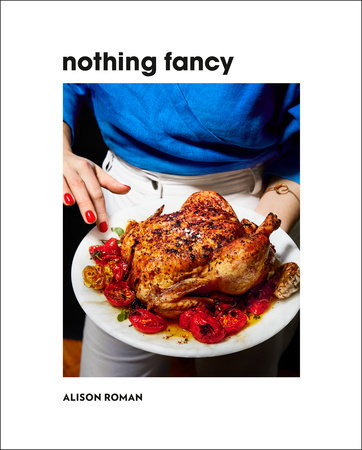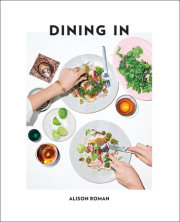This is not a book about entertaining.“Roasting a nice chicken for people is such a good way to say, ‘I love you.’” I recently found this note to myself scrawled on the back of an electrical bill I had probably forgotten to pay, written one night after a dinner party. There was likely a lot of wine that night (the best ideas always come from a lot of wine), which explains my poor penmanship and well-intentioned (but fragmented) deep chicken thought.
Not exactly poetry, but I realized after reading it that it was the first time I articulated exactly what I wanted this book to be about it and what I want you to get out of it: Using your time and resources to feed people you care about is the ultimate expression of love. And love is about expressing joy, not producing anxiety, so the other thing I want you to get out of it is: You can do this.
I have always been allergic to the word “entertaining,” which to me implies there’s a show, something performative at best and inauthentic at worst. But having people over? Well, that’s just making dinner, but you know, with more people. Unfussy food, unfussy vibes and the permission to be imperfect, no occasion necessary (other than to eat, of course).
For anyone looking for tips on how to fold linen napkins or create floral arrangements, I am not your girl. I don’t have any clever hosting tips, and I will not teach you the secrets to mood lighting. (I told you, this is not an entertaining book, but also: candles!) But I will give you low-stress and high-impact recipes and ideas designed to make your life easier when cooking for others. Colorful platters of vegetables doused in crispy crunchy bits, casually roasted meat scattered with herbs, one-bowl just-sweet-enough desserts.
This book is organized by how I like to put together most meals, broken up by what I think are the five most important parts: snacks, salads, sides, mains, and sweet things. Not to say all categories must be represented to have a complete experience, but using that framework is a good place to start.
Most of the recipes serve 4 to 6 people and are designed to be doubled easily. If you’re cooking for fewer than four, well then consider the bounty a gift to your future self in the form of leftovers. There are carefully considered do-aheads (my favorite phrase) and ideas for what goes with what, although I will say most things in this book would be so happy served next to one another (I find the concept of menus to be both inspiring and creatively stifling, so consider this my compromise). It’s a book with a true choose-your-own-adventure spirit, encouraging you to make as many or as few of the dishes as you wish.
This is not about living an aspirational life; it’s about living an attainable one. You know, the one that comes with not really having enough time to braise a whole pot of short ribs before people arrive (but you try anyway), accidentally burnt cakes (just cut those parts off), and not enough chairs to seat everyone at once (sit on the floor?). It’s the life we live, it’s messy as hell, it’s nothing fancy—I’m sure you wouldn’t want it any other way.
Three Helpful Things
1. Ask for help “Asking for help is not a weakness, it’s a strength.” —me to myself every time I cook for others If you’re a control freak like me, delegating does not come easily. But come to think of your guests as contributors and collaborators and you’ll notice everyone loosen up, things happen more quickly, and the whole vibe gets significantly more fun. Asking guests to participate by picking the stems from herbs, mixing a yogurt sauce, or slicing vegetables is a small but significant way to ease the load.
2. Pick your battles One of the most common questions I get is “How do I make sure everything is hot when I serve dinner?” My answer is always: You don’t. Trying to make sure everything is pipinghot is a fool’s errand, and one I refuse to participate in. Unless you’re living an exclusively soup-and-stew lifestyle, there is no reason every dish on your table needs to be hot. If you are serving a pasta that should be, then guess what, you’re getting a side of blanched and room-temp broccoli. If that stewed pork with kimchi needs to be piping-hot, then everything else has been made hours ago and stored in the fridge, probably. Pick your battles. Serving different foods that all need to be hot at the same time should not be one of them.
3. Never apologize Having people over means never having to say you’re sorry. Not for your mismatched plates or the fact that you don’t own any “real” wineglasses or the fact that dinner is actually being served closer to 9:30 than the hoped-for 7:30 (just make sure there are snacks). Embrace the quirky imperfections that make dinner at your house special and different. It’s not a restaurant—you shouldn’t feel pressure to make it feel like one.
Copyright © 2019 by Alison Roman. All rights reserved. No part of this excerpt may be reproduced or reprinted without permission in writing from the publisher.







